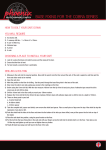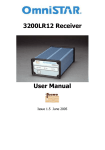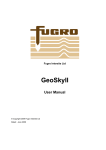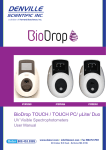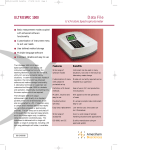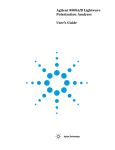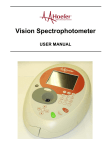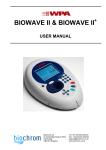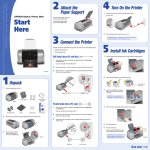Download FOASsafetyalert GMO_..
Transcript
SAFETY ALERT Fugro Company: Location/Site: Date and Time: Consequences: Incident Potential Incident Description Fugro Oceanor A/S Offshore Sipadan Island, Malaysia th 18 October 2012 Fatality High Medium Low On the 18th October 2012 one of our staff was fatally injured during the recovery and maintenance of a Fugro OCEANOR Wavescan buoy offshore Malaysia. This summary outlines the course of events leading to the accident, as well as the technical findings of the subsequent investigations. A summary of the resulting corrective measures proposed is also given. The buoy in question was deployed in August 2010, and visited for cleaning in November 2010. It was reported that the buoy was soiled with bird droppings. At some point after this, the maintenance program for the buoy was suspended. The program was re-established in 2012, and the accident took place on the initial maintenance cruise. After retrieval onto the service vessel, the buoy was cleaned, and the task of opening the instrument compartment started. This compartment also holds the lead-acid battery packs of the buoy. Access to the instruments is gained by removing a circular lid which is secured by 16 bolts. The removal of the bolts had been completed, except for the last bolt which proved to be seized. The decision was made to free this bolt using an angle grinder. Only moments after applying the grinder, an explosion took place which resulted in the lid blowing open and the instrument modules and their mounting plate being projected outwards with great force. These items struck our employee, thus causing the fatal injuries. Injuries / Medical treatment required Buoy Description Fatality The Wavescan buoy has a discus shaped hull that can be split in two to ease transportation. A keel with counterweight is mounted under the hull to stabilise the buoy. A cylinder in the middle of the buoy’s hull contains all electronic modules, the power package and the wave sensor. The different electronic modules are mounted into special splash proof compartment boxes to secure safe handling of the sensitive electronics. The buoy is equipped with a mast to support the meteorological sensors and the communication antennae. The dimensions in the diagram below are in millimetres. Findings Our initial investigation concluded that the explosion was caused by sparks from the grinder igniting an explosive mixture of hydrogen and oxygen which had built up inside the compartment. The hydrogen build-up was assumed to stem from the lead-acid batteries. The lead acid batteries contained in all Fugro Oceanor buoys are of the so called valve regulated type, meaning that they are sealed, except for a pressure relief valve. The batteries feature a built-in gas recombination system, and the small amounts of gas still released through the valve will be led through an additional catalyst before being conveyed to the outside of the buoy. This system will take care of any expected build-up of hydrogen. The final technical investigation showed no sign of malfunction of the battery venting system. The same investigation concludes that the following chain of events led to the hydrogen build-up, and eventually the accident. Lessons learnt Recommendations and corrective action Corrosion around lid sealing due to bird droppings and rain or sea spray caused sealing to fail Water, sea salt and guano ingression into the instrument compartment past the leaking lid sealing Corrosion and subsequent volume increase on details of battery rack due to ingression Increased pressure on batteries from rack, resulting in cracked battery cases Hydrogen build up due to one or more of these effects Corrosion of aluminium, accelerated by guano and sea salts dissolved in water Corrosion due to spilled battery acid from cracked batteries Gas leakage from cracked battery cases Hydrogen escapes due to leaking lid sealing and increasing temperature Grinder ignites hydrogen The subsequent design review resulted in a list of safety barriers which could or should have prevented the accident. The list below can at the same time serve as a check list for measures that will be made available by Fugro OCEANOR. It should be noted that bird spikes and a protective cover was scheduled for installation on the buoy in question. Warning in manual against ignition sources (Was in place) Instructions in manual on purging the instrument compartment Protective cover over instrument compartment lid Bird spikes Warning sign Improved purging arrangement ( Available now) Clearer instructions in manual (Was in place) (Was available) (Was available) (Available now) (Available soon) We emphasize that the user manuals for all Fugro OCEANOR buoys already state that the buoys have to be purged before opening the lid to the instrument compartment. The buoys incorporate valves allowing this procedure. In the present case the procedure was not followed. For this reason, the above items on warning sign, improved purging arrangement and clearer instructions have been given high priority. We are also considering solutions for monitoring the instrument compartment, as well as improvements to the design of the battery rack and the instrument compartment. All changes will be planned and implemented according to our procedures for product development. Our investigations regarding the cause of the accident are now complete. Our conclusion is that the accident was due to a combination of lack of maintenance and an established shortcut in the handling procedures. Please note that the Wavescan buoy is still safe for use provided the maintenance and handling procedures are followed correctly. Clearer instructions are under preparation, which will emphasize that the buoys at all times should be treated with the assumption that they could contain an explosive gas mixture, and the following precautions taken: Alert Issued by: Exercise particular care with buoys that have not operated normally in the period prior to retrieval. Examples are buoys that have not transmitted data, buoys that are physically damaged, and buoys that have not been subject to the required maintenance Equalise the pressure inside the buoy to the ambient air pressure by opening the gas filling valves Purge the interior of the buoy with air or nitrogen in order to remove any possibility of hydrogen gas. The flushing procedure is described in the Wavescan user manual Do not allow any ignition source near the buoy until it is fully opened. This certainly includes power tools. Do not smoke in the vicinity of the buoy Keep your distance. Only the minimum required number of persons should be in the vicinity of the buoy until it is fully opened. Never stand in direct line of the instrument compartment lid. When flushing has been completed, proceed immediately with the opening of the lid Leave the lid fully open for a further 10 minutes Safety Alert Reference No.


